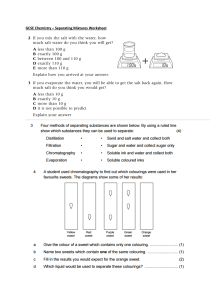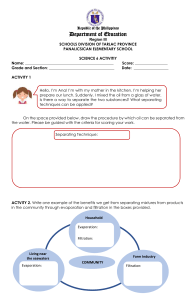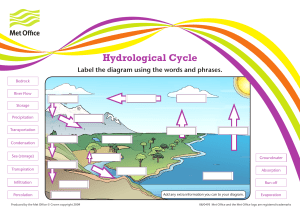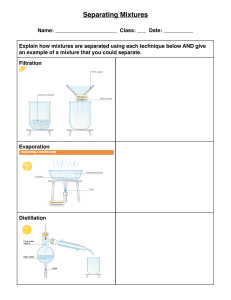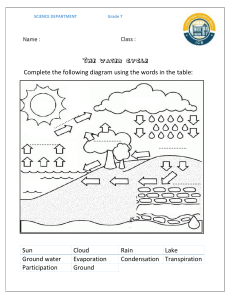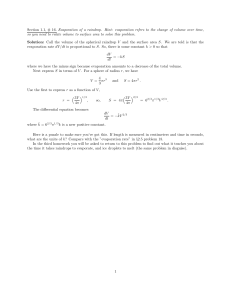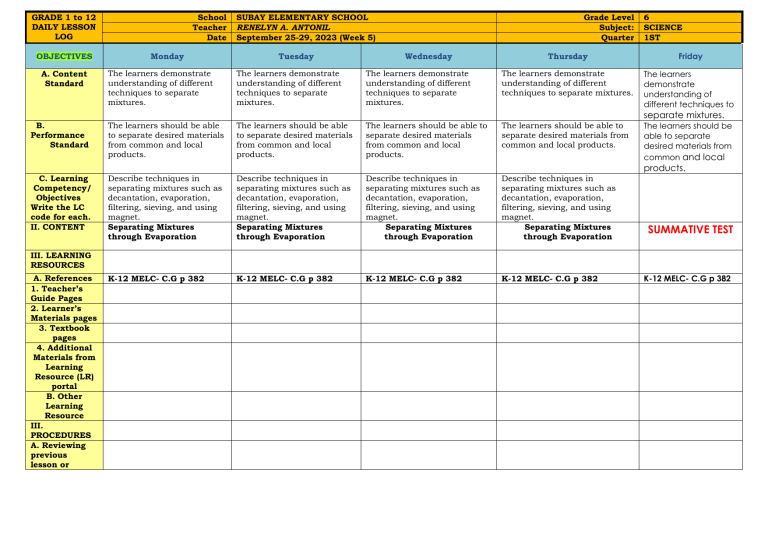
GRADE 1 to 12 DAILY LESSON LOG OBJECTIVES School Teacher Date Monday SUBAY ELEMENTARY SCHOOL RENELYN A. ANTONIL September 25-29, 2023 (Week 5) Tuesday Grade Level Subject: Quarter Wednesday Thursday Friday The learners demonstrate understanding of different techniques to The learners demonstrate understanding of different techniques to separate mixtures. The learners demonstrate understanding of different techniques to separate mixtures. The learners demonstrate understanding of different techniques to separate mixtures. The learners demonstrate understanding of different techniques to separate mixtures. B. Performance Standard The learners should be able to separate desired materials from common and local products. The learners should be able to separate desired materials from common and local products. The learners should be able to separate desired materials from common and local products. The learners should be able to separate desired materials from common and local products. C. Learning Competency/ Objectives Write the LC code for each. II. CONTENT Describe techniques in separating mixtures such as decantation, evaporation, filtering, sieving, and using magnet. Separating Mixtures through Evaporation Describe techniques in separating mixtures such as decantation, evaporation, filtering, sieving, and using magnet. Separating Mixtures through Evaporation Describe techniques in separating mixtures such as decantation, evaporation, filtering, sieving, and using magnet. Separating Mixtures through Evaporation Describe techniques in separating mixtures such as decantation, evaporation, filtering, sieving, and using magnet. Separating Mixtures through Evaporation K-12 MELC- C.G p 382 K-12 MELC- C.G p 382 K-12 MELC- C.G p 382 K-12 MELC- C.G p 382 A. Content Standard 6 SCIENCE 1ST separate mixtures. The learners should be able to separate desired materials from common and local products. SUMMATIVE TEST III. LEARNING RESOURCES A. References 1. Teacher’s Guide Pages 2. Learner’s Materials pages 3. Textbook pages 4. Additional Materials from Learning Resource (LR) portal B. Other Learning Resource III. PROCEDURES A. Reviewing previous lesson or K-12 MELC- C.G p 382 presenting the new lesson B. Establishing a purpose for the lesson What is filtering? What is evaporation? Look at the picture below. Why heat of the sun is very essential in making dried fish? C. Presenting examples/ instances of the new lesson Show a picture of a kettle with hot water. Matter in the form of solid, liquid, and gas is affected by different conditions around it. One of these conditions is exposure to heat. What is the picture all about? Do you wash your clothes by yourself? After washing the clothes, what do you do to dry them? What do you think makes clothes dry? What technique of separating components in a mixture does it show? Why do you place washed clothes under the sun? D. Discussing new concepts and practicing new skills #1 One of the main ingredients in cooking food is salt. Salt serves as an important element in our planet because of its many uses. We often see the crystal white color that adds savor to our everyday meal. Salt is also used as component of other products sold in the market. But, have you ever wondered how salt is made? As heat is used by animals and plants as the main source of energy it is also useful in so many things in the process of evaporation as one of the techniques in separating mixtures. Evaporation is a process that uses heat to separate a dissolved solid from a liquid. The solution is heated so that the solvent evaporates leaving the solid behind. Evaporation commonly occurs in everyday life. Evaporation has a great role in daily life. The knowledge on the importance of evaporation as a technique to separate components in a mixture is very useful to all of us. It can be easily visualized when rain puddles “disappear” on a hot day or when wet clothes dry under the sun. In these examples, the liquid water is not actually vanishing. It is evaporating into the atmosphere. E. Discussing new concepts and practicing new skills #2 Heat is an important component to our environment as it makes green things live and grow abundantly, the presence of the sun’s heat serves as the main source of energy in our planet as it brings many uses to the biotic known as livings things and abiotic or non-living things components of our surroundings. Evaporation Evaporation is a process of separating mixtures which involves heating the solution until the solvent evaporates leaving behind the solid residue. Heat, being the main component in this process, separates the mixtures of solid from a liquid. As liquid goes in the air in a form of gas when heated, changing liquid to gas as an example of physical change. Some examples of evaporation are boiling water, drying clothes and drying of wet roads after heavy rain. Direction: Read the following. Write your answer in your journal. 1. In a Grade 6 Science class a group of pupils would like to separate salt from water. What method will they use to separate the mixture? Explain your answer. 2. In the illustration shown below, explain a few sentences the technique of separating mixtures and give the benefit of separating it. The seawater goes through evaporation which results in the formation of salt crystals. Rock salt occurs in vast beds of sedimentary evaporated minerals that result from the drying up of enclosed lakes, beaches and seas. F. Developing mastery (leads to Formative Assessment 3) Write E if the following conditions undergo the evaporation technique of separating mixtures and N if not. Direction: Identify the technique of separating mixtures. Write F for filtering and S for sieving. Use a separate sheet of paper. 1. powder milk with small stone - _______ 2. sand from stone - _______ 3. alcohol from coins - ____ 4. grind rice from buttons - _ 5. grind coffee from hot water - Direction: Put a ü before the number if the technique used is Evaporation and X if not. _______ 1. water cycle _______ 2. using cell phone _______ 3. pulling a chair _______ 4. drying of hair using hair dryer _______ 5. boiling camote Direction: Write TRUE if the statement is correct and FALSE if it is wrong. Write your answer on a separate sheet of paper. _______ 1. Evaporation is when a liquid becomes a gas. _______ 2. When water evaporates, it becomes solid. _______ 3. Evaporation means changing from a liquid to a gas. _______ 4. Evaporation is when water gets warm and changes from water-to-water vapor. _______ 5. Evaporation is gas to liquid. Direction: Read the conditions stated in the box. Pick out those that undergo evaporation process. Write your answer in your notebook. In your daily activities at home think of 5 chores where evaporation technique is involved in accomplishing your activity. Explain your answer using complete sentences. You can also draw or use picture in explaining your How about the kitchen’s most popular seasoning, the salt? Where does it come from? How is it formed? G. Finding practical application of concepts and skills in daily living 1. water in the canal becomes less after the rain ___________ 2. doormat on the floor ___________ 3. wet hair becomes dry ___________ 4. chair on the ground ___________ 5. cooling after sweating ___________ Give 3 examples of situations where evaporation process was observed. 1. 2. 3. answer. Write them in your Science journal. H. Making generalizations and abstractions about the lesson I. Evaluating learning What kind of material was left behind when mixture was heated? What is evaporation? Direction: Write the letter with the correct answer. Do it in your science journal or notebook. 1. What method is used to obtain salt from sea water? a. decantation c. evaporation b. sedimentation d. filtering 2. Which of the following examples undergo evaporation process? a. a pail of water under the heat of the sun b. brushing your teeth after meal c. ironing clothes every weekend d. listening to the radio 3. It is the main factor that causes evaporation process in separating mixtures. a. water c. smoke b. heat d. light 4. Princess accidentally spill a glass of water in the salt container, and she is thinking of a solution on how she’s going to recover salt from water. What will Princess do to return the salt to its original phase? a. She will wrap it with newspaper tightly Direction: Choose the letter of the correct answer. Write your answer in your journal. 1. Lester had noticed that the amount of water in a container with a plant becomes less as the days goes by. What do you think is the reason of decreasing amount of water in a container? a. Some insects sipped the water. b. Water in the container was not changed. c. Water evaporated because of heat. d. The plant has a stem. 2. Which of these examples show evaporation process as technique of separating mixtures? a. drying of water on the table b. flooding of water in the river What kind of change is involved in evaporation process? Direction: Choose the letter of the best answer. Write the letter of your answer on a separate sheet of paper. 1. If salt has been dissolved in water, how could I separate it from the water again? A. by decanting B. by dissolving C. by evaporating D. by handpicking 2. To separate salt from the water, we could _________ . A. melting it B. using a magnet C. taking the water off D. evaporating the water so the salt is left behind. 3. Which of the following statements best describes evaporation? The process by which ____________________________ ________. A. liquid changes directly into a gas B. substance is made by a chemical reaction C. particles leave a liquid and become a gas What is needed to achieve evaporation process? Direction: Check (✓) the activities that involves evaporation and mark X if it is not. Write your answer on a separate sheet of paper. b. She will throw it away in the waste can c. She will hide it in a dark corner d. She will boil the solution 5. While boiling water in a kettle, Gwayne noticed that there is smoke coming from the spout of a kettle. He asked his mother, “Why did the smoke rise upward”? What do you think will be the mother’s answer? a. because the water reached its cooling point b. because the water reached its boiling point c. because the water is heated and became water vapor d. because the water is freezing c. cooling of water in the refrigerator d. freezing of water in the ocean 3. What technique will Jocelyn use if she wants to separate salt mixed with water in a container? a. filtering c. picking b. evaporation d. sedimentation 4. In evaporation process, liquid becomes _______________ when heated. a. solid c. plasma b. ice cubes d. vapor 5. It is a process of separating mixtures which involves heating leaving the solid residue in a container. a. evaporation c. distillation b. precipitation d. sedimentation D. particles leave a gas and become a liquid 4. Which of the following examples below is NOT evaporation? A. boiling water B. alcohol bottle left open C. cold water in the basin D. drying clothes under the sun 5.How do table salts created? Table salt is created by ____________________________ ______________. A. decanting the sea water B. filtering the sea water repeatedly C. collecting the water vapor from sea water D. the evaporation of sea water through industrial or natural processes, resulting in salt crystals. J. Additional activities for application or remediation Prepared by: RNELYN A. ANTONIL T-III NOTED: ANGELA R. AGAS Principal I
